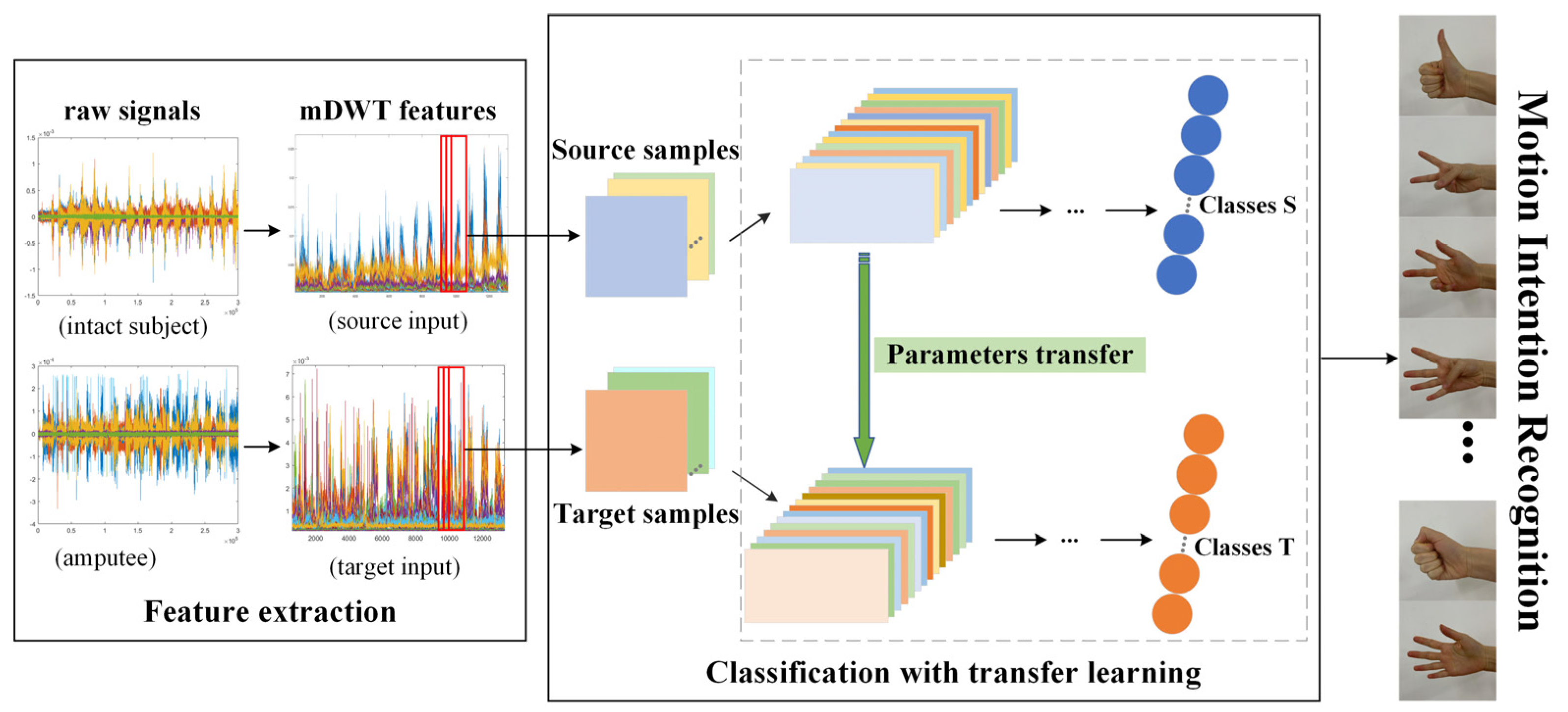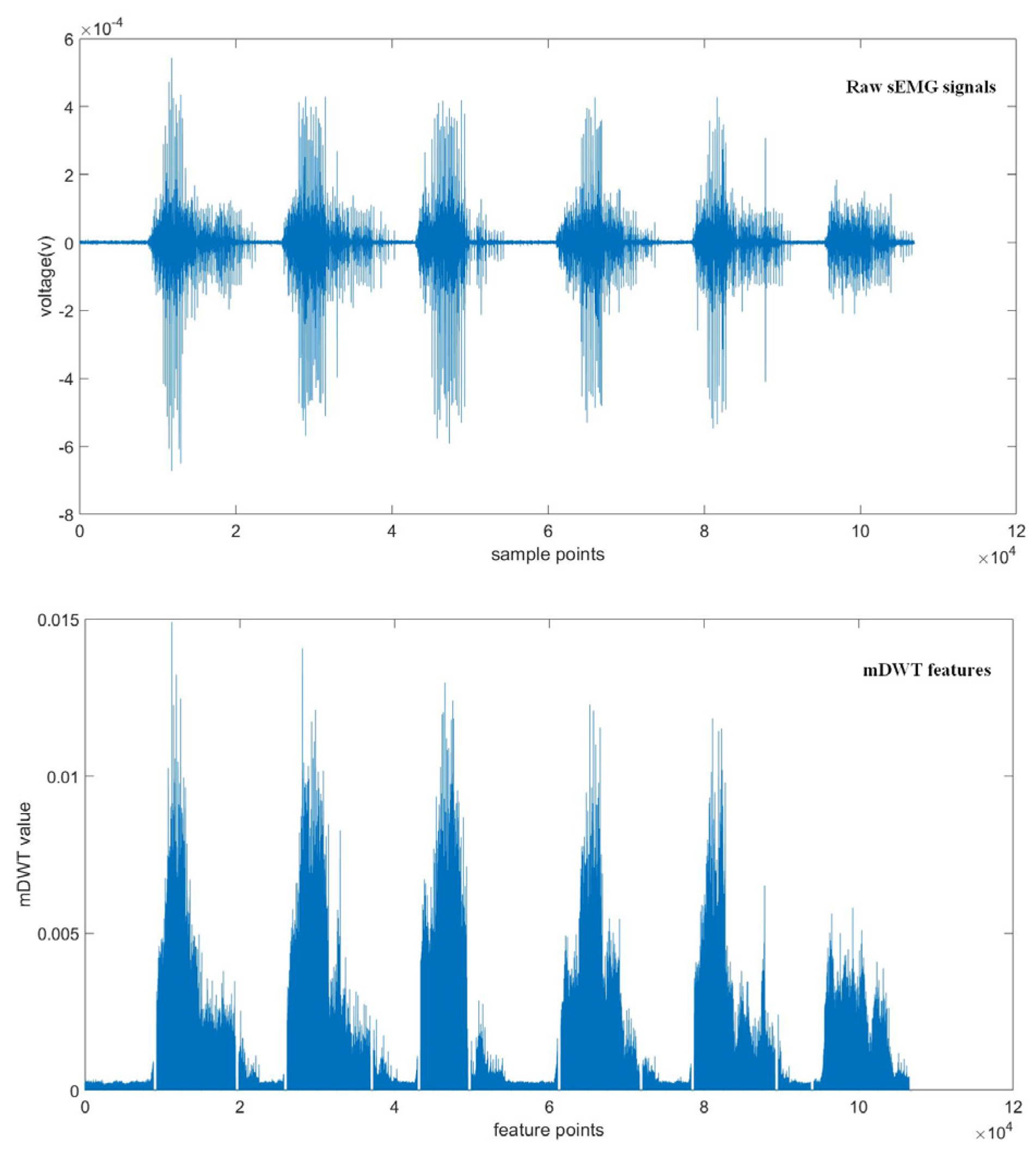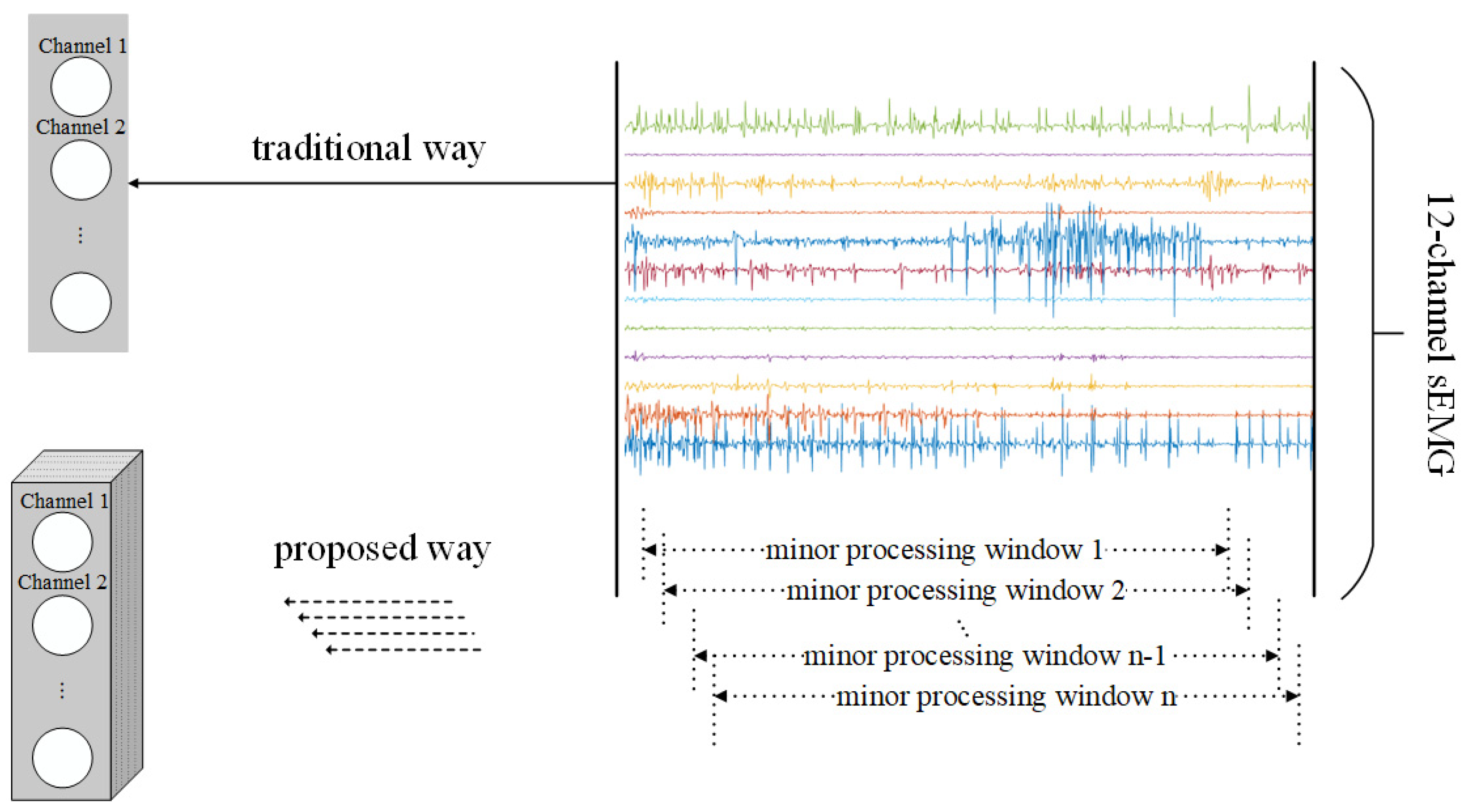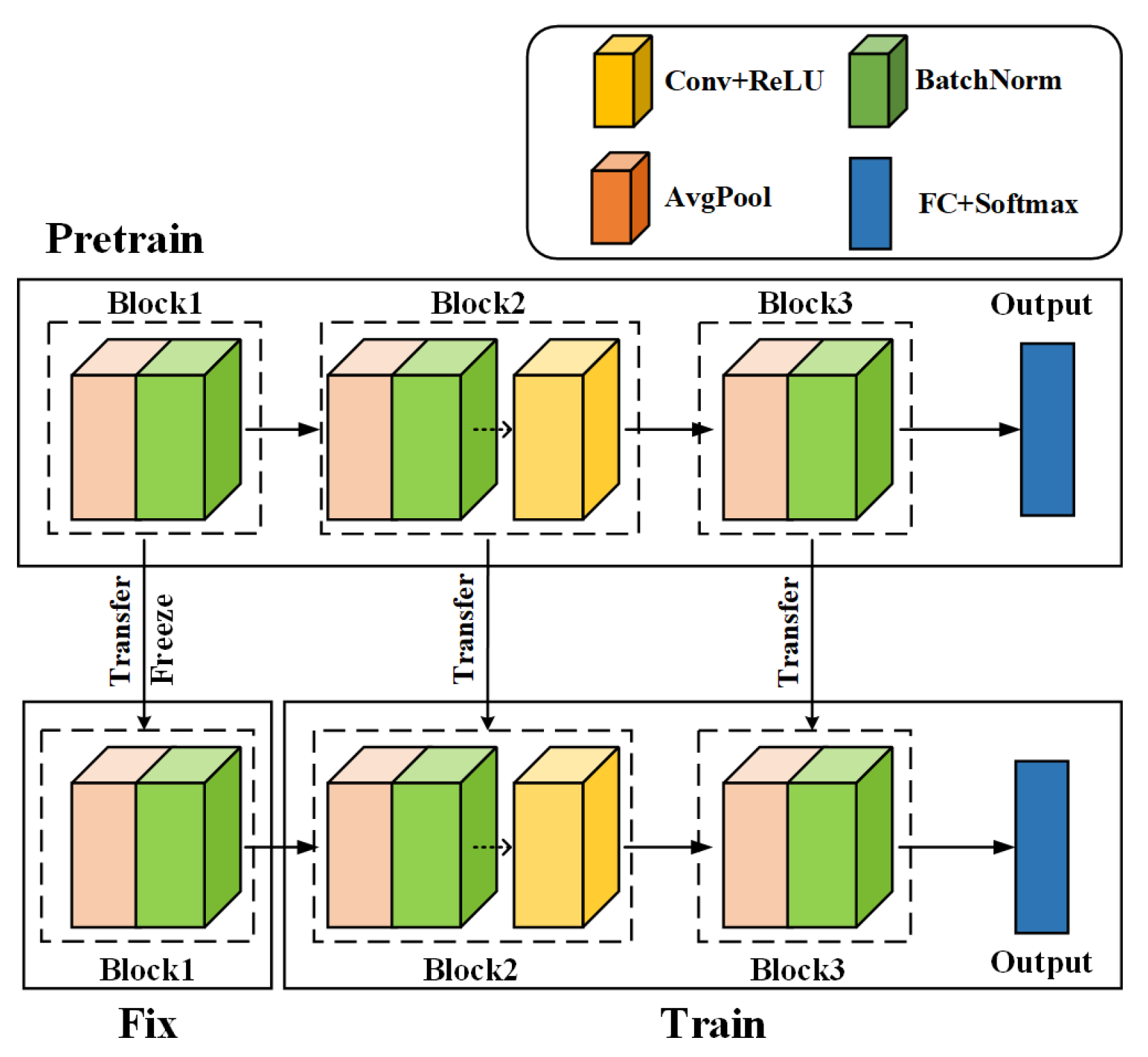Improving Motion Intention Recognition for Trans-Radial Amputees Based on sEMG and Transfer Learning
Abstract
:1. Introduction
2. Materials and Methods
2.1. Dataset
2.2. Feature Extraction
2.3. Gesture Recognition Using LECNN
2.3.1. Long-Exposure Segmentation
2.3.2. Long-Exposure Convolutional Neural Network (LECNN)
2.4. Transfer Learning
2.5. Experiments and Data Analysis
3. Results
3.1. Classification Accuracy on Intact-Limb Subjects
3.2. Classification Accuracy on Intact-Limb Subjects
3.3. Classification Accuracies on Different Gestures
4. Discussion
4.1. The Classification Accuracy Comparison with Other Typical Methods
| Gregori, Gijsberts et al. [37] | Fan, Jiang et al. [19] | Proposed | |
|---|---|---|---|
| Motions | 17 | 17 | 17 |
| Int./Amp. | 20/9 | 20/11 | 20/11 |
| Features | Avg. MAV/VAR/WL | mDWT | mDWT |
| Classifier | SVM | CNN | LECNN |
| Non-transfer | 52.1% | 62.0% | 73.4% |
| Transfer | 51.9% | 67.5% | 78.1% |
| Improvement | −0.02% | 5.5% | 4.7% |
| Gestures | Amputees | Features | Model | Accuracy | |
|---|---|---|---|---|---|
| Atzori, Cognolato et al. [32] | 50 | 11 | RMS | SVM | 42.7% |
| Arunraj, Srinivasan et al. [26] | 50 | 11 | LV/ARC/WL/MAV | RFM | 53.3% |
| Cene and Balbinot [33] | 17 | 10 | RMS | CNN | 56.9% |
| Cene and Balbinot [34] | 17 | 11 | Avg. RMS/MAV/SD | ELM | 67.0% |
| Tosin, Cene et al. [35] | 17 | 10 | Feature Selection | SVM-REF | 74.8% |
| Zhai, Jelfs et al. [36] | 10 | 10 | Spectrogram | CNN | 73.3% |
| Fan, Jiang et al. [19] | 17 | 11 | mDWT | CNN | 67.5% |
| Fan, Jiang et al. [19] | 17 | 10 | mDWT | CNN | 82.3% |
| Proposed | 17 | 11 | mDWT | LECNN | 78.1% |
| Proposed | 17 | 10 | mDWT | LECNN | 83.5% |
4.2. Correlation Analysis of Recognition Performance and Amputation Factors
4.3. Computational Cost
5. Conclusions
Author Contributions
Funding
Informed Consent Statement
Data Availability Statement
Conflicts of Interest
References
- Mills, K.R. The Basics of Electromyography. J. Neurol. Neurosurg. Psychiatry 2005, 76 (Suppl. S2), 32–35. [Google Scholar]
- Yang, G.; Li, N. Design of the Human Surface Electromyogra Signal Acquisition System and Signal Analysis. In Proceedings of the Seventh Asia International Symposium on Mechatronics; Duan, B., Umeda, K., Hwang, W., Eds.; Springer: Singapore, 2020; pp. 915–926. [Google Scholar]
- Liu, C.; Li, J.; Zhang, S.; Yang, H.; Guo, K. Study on Flexible sEMG Acquisition System and Its Application in Muscle Strength Evaluation and Hand Rehabilitation. Micromachines 2022, 13, 2047. [Google Scholar] [PubMed]
- Sung, J.H.; Baek, S.-H.; Park, J.-W.; Rho, J.H.; Kim, B.-J. Surface Electromyography-Driven Parameters for Representing Muscle Mass and Strength. Sensors 2023, 23, 5490. [Google Scholar] [PubMed]
- Ginszt, M.; Zieliński, G. Novel Functional Indices of Masticatory Muscle Activity. J. Clin. Med. 2021, 10, 1440. [Google Scholar] [PubMed]
- Li, W.; Shi, P.; Yu, H. Gesture Recognition Using Surface Electromyography and Deep Learning for Prostheses Hand: State-of-the-Art, Challenges, and Future. Front. Neurosci. 2021, 15, 621885. [Google Scholar] [PubMed]
- Copaci, D.; Arias, J.; Gómez-Tomé, M.; Moreno, L.; Blanco, D. SEMG-Based Gesture Classifier for a Rehabilitation Glove. Front. Neurorobot. 2022, 16, 750482. [Google Scholar]
- Atzori, M.; Gijsberts, A.; Castellini, C.; Caputo, B.; Hager, A.-G.M.; Elsig, S.; Giatsidis, G.; Bassetto, F.; Muller, H. Effect of clinical parameters on the control of myoelectric robotic prosthetic hands. J. Rehabil. Res. Dev. 2016, 53, 345–358. [Google Scholar]
- Schultz, A.E.; Kuiken, T.A. Neural Interfaces for Control of Upper Limb Prostheses: The State of the Art and Future Possibilities. Phys. Med. Rehabil. 2011, 3, 55–67. [Google Scholar]
- Oskoei, M.A.; Hu, H. Myoelectric Control Systems—A Survey. Biomed. Signal Process. Control. 2007, 2, 275–294. [Google Scholar]
- Li, X.; Chen, S.; Zhang, H.; Samuel, O.W.; Wang, H.; Fang, P.; Zhang, X.; Li, G. Towards Reducing the Impacts of Unwanted Movements on Identification of Motion Intentions. J. Electromyogr. Kinesiol. 2016, 28, 90–98. [Google Scholar]
- Al-Timemy, A.H.; Khushaba, R.N.; Bugmann, G.; Escudero, J. Improving the Performance Against Force Variation of EMG Controlled Multifunctional Upper-Limb Prostheses for Transradial Amputees. IEEE Trans. Neural Syst. Rehabil. Eng. 2016, 24, 650–661. [Google Scholar] [PubMed]
- Pan, S.J.; Yang, Q. A Survey on Transfer Learning. IEEE Trans. Knowl. Data Eng. 2010, 22, 1345–1359. [Google Scholar]
- Castellini, C.; Fiorilla, A.E.; Sandini, G. Multi-Subject/Daily-Life Activity EMG-Based Control of Mechanical Hands. J. Neuroeng. Rehabil. 2009, 6, 41. [Google Scholar] [PubMed]
- Matsubara, T.; Hyon, S.-H.; Morimoto, J. Learning and Adaptation of a Stylistic Myoelectric Interface: EMG-Based Robotic Control with Individual User Differences. In Proceedings of the 2011 IEEE International Conference on Robotics and Biomimetics, Karon Beach, Thailand, 7–11 December 2011; pp. 390–395. [Google Scholar]
- Sensinger, J.W.; Lock, B.A.; Kuiken, T.A. Adaptive Pattern Recognition of Myoelectric Signals: Exploration of Conceptual Framework and Practical Algorithms. IEEE Trans. Neural Syst. Rehabil. Eng. 2009, 17, 270–278. [Google Scholar]
- Park, K.-H.; Lee, S.-W. Movement Intention Decoding Based on Deep Learning for Multiuser Myoelectric Interfaces. In Proceedings of the 2016 4th International Winter Conference on Brain-Computer Interface (BCI), Gangwon, Republic of Korea, 22–24 February 2016; pp. 1–2. [Google Scholar]
- Côté-Allard, U.; Fall, C.L.; Drouin, A.; Campeau-Lecours, A.; Gosselin, C.; Glette, K.; Laviolette, F.; Gosselin, B. Deep Learning for Electromyographic Hand Gesture Signal Classification Using Transfer Learning. IEEE Trans. Neural Syst. Rehabil. Eng. 2019, 27, 760–771. [Google Scholar]
- Fan, J.; Jiang, M.; Lin, C.; Li, G.; Fiaidhi, J.; Ma, C.; Wu, W. Improving SEMG-Based Motion Intention Recognition for Upper-Limb Amputees Using Transfer Learning. Neural Comput. Appl. 2023, 35, 16101–16111. [Google Scholar]
- Chen, X.; Li, Y.; Hu, R.; Zhang, X.; Chen, X. Hand Gesture Recognition Based on Surface Electromyography Using Convolutional Neural Network with Transfer Learning Method. IEEE J. Biomed. Health Inform. 2021, 25, 1292–1304. [Google Scholar]
- Yu, Z.; Zhao, J.; Wang, Y.; He, L.; Wang, S. Surface EMG-Based Instantaneous Hand Gesture Recognition Using Convolutional Neural Network with the Transfer Learning Method. Sensors 2021, 21, 2540. [Google Scholar]
- Soroushmojdehi, R.; Javadzadeh, S.; Pedrocchi, A.; Gandolla, M. Transfer Learning in Hand Movement Intention Detection Based on Surface Electromyography Signals. Front. Neurosci. 2022, 16, 977328. [Google Scholar]
- Ozdemir, M.; Kisa, D.; Guren, O.; Akan, A. Hand Gesture Classification Using Time-Frequency Images and Transfer Learning Based on CNN. Biomed. Signal Process. Control. 2022, 77, 103787. [Google Scholar]
- Atzori, M.; Gijsberts, A.; Castellini, C.; Caputo, B.; Hager, A.-G.M.; Elsig, S.; Giatsidis, G.; Bassetto, F.; Müller, H. Electromyography Data for Non-Invasive Naturally-Controlled Robotic Hand Prostheses. Sci. Data 2014, 1, 140053. [Google Scholar] [PubMed]
- Burhan, N.; Kasno, M.; Ghazali, R. Feature Extraction of Surface Electromyography (SEMG) and Signal Processing Technique in Wavelet Transform: A Review. In Proceedings of the 2016 IEEE International Conference on Automatic Control and Intelligent Systems (I2CACIS), Selangor, Malaysia, 22–22 October 2016; pp. 141–146. [Google Scholar]
- Arunraj, M.; Srinivasan, A.; Arjunan, S. A Real-Time Capable Linear Time Classifier Scheme for Anticipated Hand Movements Recognition from Amputee Subjects Using Surface EMG Signals. IRBM 2021, 42, 277–293. [Google Scholar]
- Phinyomark, A.; Scheme, E. EMG Pattern Recognition in the Era of Big Data and Deep Learning. Big Data Cogn. Comput. 2018, 2, 21. [Google Scholar]
- Geng, W.; Du, Y.; Jin, W.; Wei, W.; Hu, Y.; Li, J. Gesture Recognition by Instantaneous Surface EMG Images. Sci. Rep. 2016, 6, 36571. [Google Scholar] [CrossRef] [PubMed]
- Du, Y.; Jin, W.; Wei, W.; Hu, Y.; Geng, W. Surface EMG-Based Inter-Session Gesture Recognition Enhanced by Deep Domain Adaptation. Sensors 2017, 17, 458. [Google Scholar] [PubMed]
- Guo, W.; Ma, C.; Wang, Z.; Zhang, H.; Farina, D.; Jiang, N.; Lin, C. Long Exposure Convolutional Memory Network for Accurate Estimation of Finger Kinematics from Surface Electromyographic Signals. J. Neural Eng. 2021, 18, 026027. [Google Scholar]
- Yosinski, J.; Clune, J.; Bengio, Y.; Lipson, H. How Transferable Are Features in Deep Neural Networks? In Advances in Neural Information Processing Systems; Curran Associates, Inc.: Red Hook, NY, USA, 2014; p. 27. [Google Scholar]
- Atzori, M.; Cognolato, M.; Müller, H. Deep Learning with Convolutional Neural Networks Applied to Electromyography Data: A Resource for the Classification of Movements for Prosthetic Hands. Front. Neurorobot. 2016, 10, 9. [Google Scholar]
- Cene, V.H.; Balbinot, A. Resilient EMG Classification to Enable Reliable Upper-Limb Movement Intent Detection. IEEE Trans. Neural Syst. Rehabil. Eng. 2020, 28, 2507–2514. [Google Scholar]
- Cene, V.H.; Balbinot, A. Enhancing the Classification of Hand Movements through SEMG Signal and Non-Iterative Methods. Health Technol. 2019, 9, 561–577. [Google Scholar]
- Tosin, M.C.; Cene, V.H.; Balbinot, A. Statistical Feature and Channel Selection for Upper Limb Classification Using SEMG Signal Processing. Res. Biomed. Eng. 2020, 36, 411–427. [Google Scholar]
- Zhai, X.; Jelfs, B.; Chan, R.H.M.; Tin, C. Self-Recalibrating Surface EMG Pattern Recognition for Neuroprosthesis Control Based on Convolutional Neural Network. Front. Neurosci. 2017, 11, 379. [Google Scholar] [PubMed]
- Gregori, V.; Gijsberts, A.; Caputo, B. Adaptive Learning to Speed-up Control of Prosthetic Hands: A Few Things Everybody Should Know. In Proceedings of the 2017 International Conference on Rehabilitation Robotics (ICORR), London, UK, 17–20 July 2017; pp. 1130–1135. [Google Scholar]
- Wang, H.; Fang, P.; Tian, L.; Zheng, Y.; Zhou, H.; Li, G.; Zhang, X. Towards Determining the Afferent Sites of Perception Feedback on Residual Arms of Amputees with Transcutaneous Electrical Stimulation. In Proceedings of the 2015 37th Annual International Conference of the IEEE Engineering in Medicine and Biology Society (EMBC), Milan, Italy, 25–29 August 2015; Volume 2015, pp. 3367–3370. [Google Scholar]









| Subject | Handedness | Amputated Hand(s) | Remaining Forearm (%) | Year Since Amputation | Prosthesis Use |
|---|---|---|---|---|---|
| 1 | Right | Right | 50 | 13 | Myoelectric |
| 2 | Right | Left | 70 | 6 | Cosmetic |
| 3 | Right | Right | 30 | 5 | Myoelectric |
| 4 | Right | Right and Left | 40 | 1 | No |
| 5 | Left | Left | 90 | 1 | Kinematic |
| 6 | Right | Left | 40 | 13 | Kinematic |
| 7 | Right | Right | 0 | 7 | No |
| 8 | Right | Right | 50 | 5 | Myoelectric |
| 9 | Right | Right | 90 | 14 | Myoelectric |
| 10 | Right | Right | 50 | 2 | Myoelectric |
| 11 | Right | Right | 90 | 5 | Myoelectric |
Disclaimer/Publisher’s Note: The statements, opinions and data contained in all publications are solely those of the individual author(s) and contributor(s) and not of MDPI and/or the editor(s). MDPI and/or the editor(s) disclaim responsibility for any injury to people or property resulting from any ideas, methods, instructions or products referred to in the content. |
© 2023 by the authors. Licensee MDPI, Basel, Switzerland. This article is an open access article distributed under the terms and conditions of the Creative Commons Attribution (CC BY) license (https://creativecommons.org/licenses/by/4.0/).
Share and Cite
Lin, C.; Niu, X.; Zhang, J.; Fu, X. Improving Motion Intention Recognition for Trans-Radial Amputees Based on sEMG and Transfer Learning. Appl. Sci. 2023, 13, 11071. https://doi.org/10.3390/app131911071
Lin C, Niu X, Zhang J, Fu X. Improving Motion Intention Recognition for Trans-Radial Amputees Based on sEMG and Transfer Learning. Applied Sciences. 2023; 13(19):11071. https://doi.org/10.3390/app131911071
Chicago/Turabian StyleLin, Chuang, Xinyue Niu, Jun Zhang, and Xianping Fu. 2023. "Improving Motion Intention Recognition for Trans-Radial Amputees Based on sEMG and Transfer Learning" Applied Sciences 13, no. 19: 11071. https://doi.org/10.3390/app131911071
APA StyleLin, C., Niu, X., Zhang, J., & Fu, X. (2023). Improving Motion Intention Recognition for Trans-Radial Amputees Based on sEMG and Transfer Learning. Applied Sciences, 13(19), 11071. https://doi.org/10.3390/app131911071





